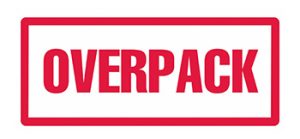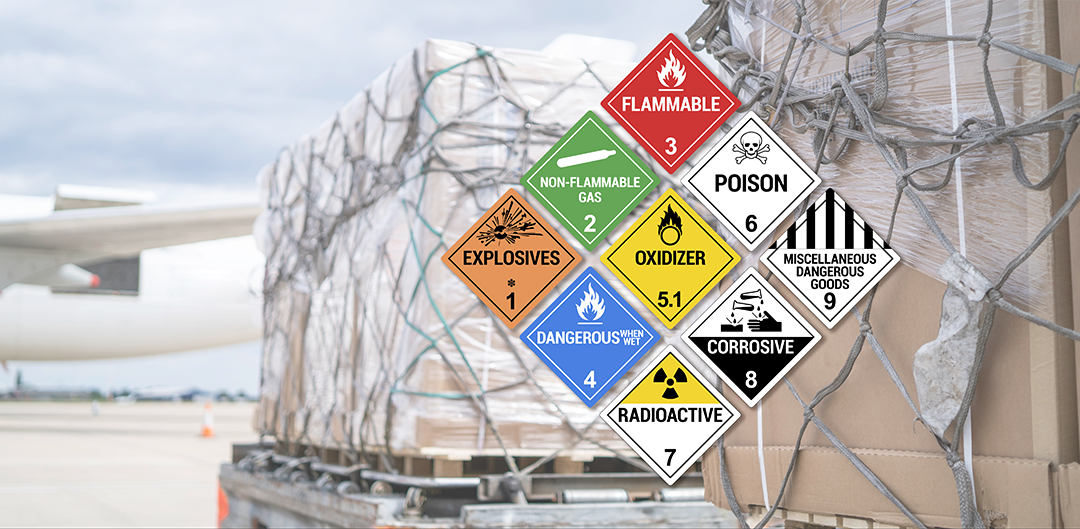Transporting dangerous goods (hazardous materials) by air involves stringent regulations and protocols to ensure safety and compliance with international standards. International standards for transporting these goods by air, which can include hazardous materials such as flammable liquids, explosives, and toxic substances, are governed by the International Civil Aviation Organization (ICAO) and implemented by the International Air Transport Association (IATA). In the United States, the Federal Aviation Administration is responsible for ensuring compliance with these standards and additional US Federal Regulations for transporting dangerous goods by air.
Proper packaging, labeling, documentation, and handling procedures are crucial to prevent accidents and ensure the safety of ground handling personnel, passengers, crew, and cargo. Shippers, ground handlers, storage facilities, and airlines must adhere to these guidelines to mitigate risks associated with the air transport of dangerous goods.
Safe Transport of Hazardous Material Begins with Shippers
The shipper is the source of the goods to be shipped. They are responsible for every aspect of correctly identifying, packing, labeling, and documenting their dangerous goods for shipment. They must closely follow all industry regulations and guidelines for their goods to be accepted by the carrier (airline). They must also follow any additional requirements specific to their carrier of choice or the local or regional authorities of the shipment departure or destination.
Here are the key aspects that shippers need to know:
Regulations and Guidelines
It is imperative that shippers stay up-to-date on the latest international and national guidelines and regulations for hazardous materials transportation. To ensure compliance, always refer to current regulations and any notices or addendums that have been issued since the publish date.
- ICAO Technical Instructions for the Safe Transport of Dangerous Goods by Air (ICOA TI): The International Civil Aviation Organization (ICAO) sets the technical instructions for the safe international transport of dangerous goods by air. This publication is published every 2 years, with periodic addendums. The ICAO is a United Nations Agency tasked with setting standards and regulations necessary for aviation safety, security, efficiency, and regularity, as well as for aviation environmental protection.
- IATA Dangerous Goods Regulations (DGR): The IATA Dangerous Goods Regulations (DGR) is the industry standard for shipping dangerous goods by air. The DGR manual provides detailed guidelines for the packaging, labeling, and documentation of dangerous goods for shipment by air. This ‘field manual’ is published annually. It is based on the ICAO technical instructions and has been written and edited by dangerous goods experts in an easy-to-use format. The IATA and the ICAO cooperate in setting and implementing global standards for the safe carriage of dangerous goods by air.
- Hazardous Materials Regulations (HMR) – US Federal Code of Regulations: The Hazardous Materials Regulations (HMR) are a set of US laws governing the safe transportation of hazardous materials by air, land, sea, and rail. These regulations are written by the US Department of Transportation’s (DOT) Pipeline and Hazardous Materials Safety Administration (PHMSA) and published in Title 49 of the Code of Federal Regulations (49 CFR, parts 171-180). The Federal Aviation Administration (FAA) is responsible for ensuring compliance with HMR rules as they apply to air transportation. Aircraft operators are also subject to these FAA requirements.
Classification of Dangerous Goods
Dangerous goods are classified into nine classes based on the type of hazard they present and are further divided into subgroups:
- Explosives
- Gases
- Flammable Liquids
- Flammable Solids
- Oxidizing Substances and Organic Peroxides
- Toxic and Infectious Substances
- Radioactive Material
- Corrosives
- Miscellaneous Dangerous Goods
Packaging
- Packaging Instructions: When shipping dangerous goods by air, follow specific packaging instructions outlined in the IATA DGR, including:
- general packing requirements
- hazard-specific general requirements
- material-specific packing instructions
(Columns G, I, and K of the IATA DGR list of Dangerous Goods)
- Approved Packaging: Use UN-approved packaging materials that meet specific testing requirements. (IATA DGR, Appendix F: Companies that can supply UN-approved packaging)
 Overpacks: When combining multiple packages, ensure they comply with regulations.
Overpacks: When combining multiple packages, ensure they comply with regulations. Limited Quantity exceptions: Shipping dangerous goods in Limited Quantities offers the opportunity to be exempt from some parts of the regulations. When shipping limited quantities of hazardous materials by air, shippers must comply with the IATA Dangerous Goods Regulations (DGR) manual, FAA guidelines, and other requirements:
Limited Quantity exceptions: Shipping dangerous goods in Limited Quantities offers the opportunity to be exempt from some parts of the regulations. When shipping limited quantities of hazardous materials by air, shippers must comply with the IATA Dangerous Goods Regulations (DGR) manual, FAA guidelines, and other requirements:
- Limited Quantity packaging is combination packaging. Inner packaging is placed inside sturdy outer packaging and adheres to specific packaging requirements. (IATA DGR General requirements 5.02—5.04)
- Follow all ‘Y’ packing instructions for the specific material to be shipped. (IATA DGR List of Dangerous Goods, Column G: Passenger and Cargo Aircraft Limited Quantity Packing Instructions)
- Weight and volume maximums based on package type and substance. Amounts listed are net unless preceded by a G for gross weight. (IATA DGR List of Dangerous Goods, Column H: Passenger and Cargo Aircraft Limited Quantity – Maximum Net Quantity Per Package)
- The package must have a ‘Y’ label on the outside, along with all other markings and labels that are required for a fully regulated package, including UN ID number, proper shipping name, and hazard labels.
- The words ‘Limited Quantity’ or ‘LTD QTY’ must appear on shipping paper and shipper’s certification.
Labeling and Marking
- Proper Labels: Affix the correct hazard labels and handling labels.
- Markings: Include proper shipping names, UN numbers, and the shipper’s and receiver’s contact details.
Documentation
- Shipper’s Declaration: Complete the Shipper’s Declaration for Dangerous Goods accurately, including details of the goods, packaging, and emergency contact information.
- Air Waybill: Ensure the Air Waybill includes the necessary details about the dangerous goods.
Training
- Mandatory Training: Personnel involved in handling and transporting dangerous goods must undergo training in accordance with IATA and ICAO requirements.
- Refresher Courses: Regular refresher courses are necessary to stay updated with regulations.
Handling and Storage
- Handling Procedures: Follow specific handling procedures to prevent accidents during loading, unloading, and transit.
- Storage Requirements: Adhere to storage regulations, including segregation of incompatible substances to prevent reactions (e.g., acids away from bases, flammables away from oxidizers).
– Store dangerous goods in designated areas that are well-ventilated, dry, and cool.
– Ensure storage areas are secure and access is restricted to authorized personnel only.
Emergency Procedures
- Emergency Plans: Have emergency response plans in place in case of an accident or spill.
- Contact Information: Ensure emergency contact information is readily available.
Carrier Requirements
- Carrier Policies: Each airline may have additional policies and restrictions for the transport of dangerous goods.
- Advance Notification: Notify the carrier in advance about the shipment of dangerous goods.
Security
- Security Measures: Implement security measures to prevent unauthorized access to dangerous goods.
- Regulatory Compliance: Comply with international and local security regulations regarding dangerous goods.
Additional Considerations
- Special Permits: Some dangerous goods may require special permits or approvals.
- Country-Specific Regulations: Be aware of and comply with any country-specific regulations that may apply.
By following these guidelines and staying informed about current regulations, you can ensure the safe and compliant transport of dangerous goods by air.
Resources
- FAA: Packaging Your Dangerous Goods
- FAA: Dangerous Goods Advisory Bulletins
- FAA: Dangerous Goods Regulations for Air Transportation
- FAA: What are Dangerous Goods?
- FAA: Small and Limited Quantity Packaging Exceptions guide (PDF)
- FAA: Resources for Shippers & E-Commerce
- FAA: Interactive Guide to Shipping Lithium Batteries (Interactive PDF)
- FAA: Lithium Batteries Chart (PDF)
- (eCRF) Title 49 Hazardous Materials Regulations (HMR) – current version, as well as current and historical changes.
- IATA: Dangerous Goods Manuals
- IATA: Frequently Asked Questions on Transportation of Dangerous Goods by Air
- ICOA: Technical Instructions For The Safe Transport of Dangerous Goods by Air (Doc 9284)
- ICOA Blog: What You Need To Know About The Transport Of Dangerous Goods By Air
Related Articles
9 Hazard Classes For Dangerous Goods In Shipping
Transporting Perishable Goods by Air – Key Points For Shippers
To speak with a CFS Air Cargo Specialist: Phone: (866) 255-6153, email: info@cfsdtw.com – or request a callback consultation.

